火星 月惑星研究会 関西支部 (最新)
ALPO-Japan Latest
Mars Image 2003/12/14(UT)
森田光治,仁科淳良,瀧本郁夫,柚木健吉,熊森照明,池村俊彦,林敏夫,畑中明利,永長英夫,新川勝仁,平林 勇,
Christophe Pellier,Donald C Parker,Brian Colville
M.Morita,A.Nishina,I.Takimoto,K.Yunoki,T.Kumamori,T.Ikemura,T.Hayashi,A.Hatanaka,H.Einaga,M.Niikawa,I.Hirabayashi,Christophe,Don,B.Colville
解説(安達)
日本では、12月9日に見つかった黄雲の姿を熊森氏が昼間に観測するこ
とで、最も早くその姿を記録した。1日の事で西に随分拡がった様子が確認
された。北の方に伸びた黄雲の先端はソリス(Solis Lacus;90W,-25)を覆い、
南の方にできた黄雲はフォエリクス(Foelix;100W,-43)付近に拡散してい
た。その他の日本の観測者も午後のリムにその姿を認めている。クリストフ
・ペリエ(Christophe Pellier)からはシルチス(Syrtis major;290W,+10)が良
く判る観測が届いたが、黄雲は認められなかった。パーカー氏は黄雲を正面
から観測され、くもの広がりの良く判る貴重な観測記録を残された。黄雲の
全体が南に移動してる様子がはっきりと読み取れる。
(reported by 13 observers)
December 14th, 2003.
Kumamori observed the figure of the dust cloud in Japan in the daytime.
It became the earliest observation record in Japan. The state that a
dust cloud spread out in the west in one day was recorded with this
image. The point of the dust cloud which grew in the north covered
Solis lacus(90W,-25). The dust cloud which spread out in the south
diffused around Foelix(100W,-43). Most of the Japanese observation
people record a dust cloud in afternoon limb. The image of Syrtis
major(290W,+10) which it knows well has been sent from Christophe
Pellier. But, a dust cloud wasn't seen for this image. D.C.Parker
observed a dust cloud from the front. This is the important report
that it knows the extent of the cloud. It knows the state that the
whole of the dust cloud is moved to the south well.
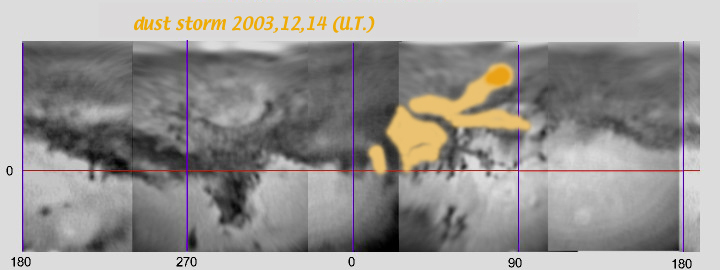 FROM Makoto ADACHI
-------------------------------------------------------------------------------------
FROM Makoto ADACHI
-------------------------------------------------------------------------------------
|
Mitsuji Morita(203mm Newton, Philips ToUcam Pro PCVC740K)
|
|
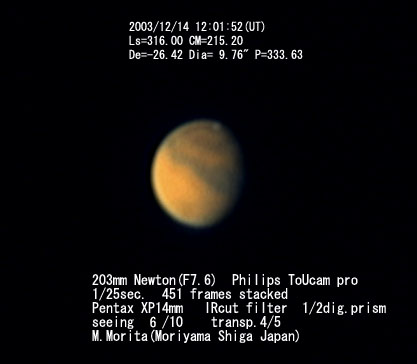
昨夜に比べ、比較的安定した気象条件
であった。南極冠が明瞭に確認できる。
≪滋賀県守山市 森田光治≫
|
Atuyoshi Nishina (250mm Mewlon ;ToUcam Pro)
|
|
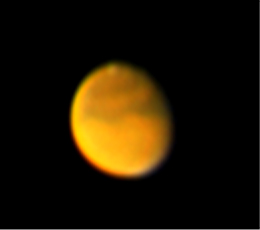
2003/12/14 10:20:00(UT)
Ls=315.96 CM=190.65
De=-26.30 Dia= 9.76" P=333.65
300frames composite
Seeing:5/10,Trans3/5
Mars was photoed after a long time.
Seeing was not good.
It had a appreciation of the power of Registax.
≪埼玉県上尾市 仁科淳良≫
|
Ikuo Takimoto (310mm Newtonian :ToUcam Pro )
|
|
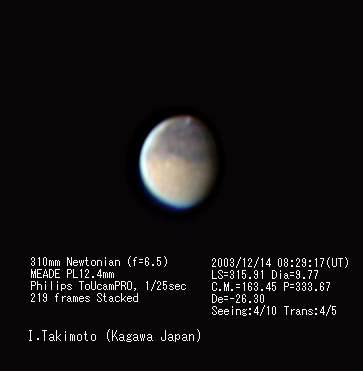
2003/12/14 08:29:17(UT)
C.M.=163.45
P=333.67
LS=315.91 Dia.=9.77"
219 frames Stacked
Seeing:4/10 Trans:4/5
---------------------------------
コメント:冷たい風が吹いてきた。南極冠健在
[Ayauta-gun Kagawa-Prefecture Japan]
≪香川県 綾歌郡 瀧本郁夫≫
|
Kenkichi.Yunoki (200mm Newtonian, ToUcam Pro)
|
|
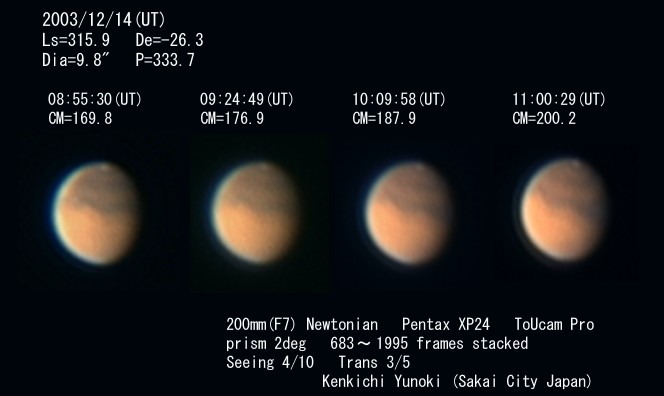
[Kenkichi Yunoki (Sakai City Japan)]
≪大阪府 堺市 柚木健吉≫
|
Teruaki Kumamori (600mm Cassegrain , PHILIPS ToUcam Pro)
|
|
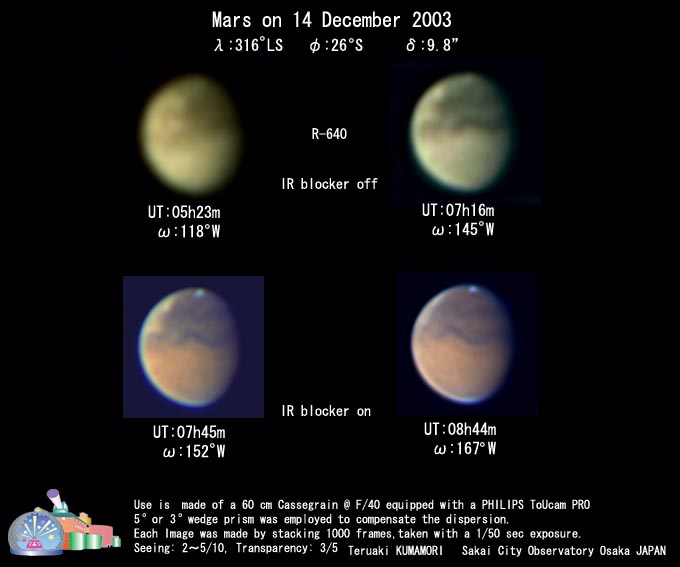
日中の撮影はなかなか難しく、太陽の熱でぬくもった空気が
望遠鏡の前を通って火星が大きく跳びはねていました。
黄雲は太陽湖を覆ってしまったようです。
日没ごろからシーイングは良くなり南極冠が小さく写りました。
≪大阪府 堺市 熊森照明≫
|
Toshihiko Ikemura (310mm Newton, Philips ToUcam PRO)
|
|

左上リムが異常に明るい。
ダストストームの影響かもしれません。
シーイングが良いと思ったのですが、
思ったほど撮れませんでした。
[T.Ikemura Nagoya Aichi JAPAN]
≪愛知県名古屋市 池村俊彦≫
|
林敏夫 Toshio Hayashi (355mm Schumidt-Cassegrain, Philips ToUcam Pro )
|
|
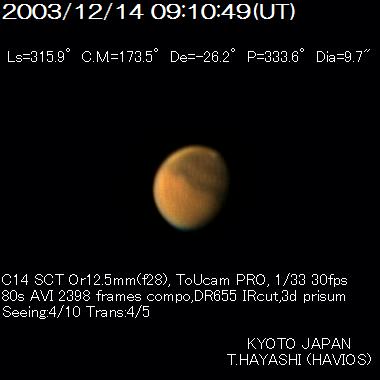
土曜に引きつずき、南中過ぎてもシーングは良かったです。
南極冠もしっかり確認できます。皆さんも感心されている通り
10秒を切っても南極冠が観測されるのは、凄いですね。技術
の進歩ですかね。努力ですかね。5秒台も夢じゃないですね。
ということは木星・土星・金星と同じ年中観測が出来ることに
成りますね。
≪京都府京都市 林敏夫≫
|
Akitoshi Hatanaka (400mm Cassegrain, ToUcam Pro)
|
|
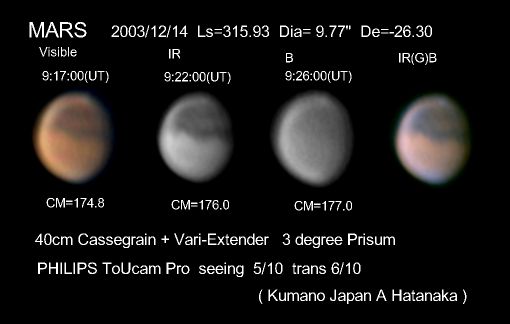
no1 Visible Image 2003/12/14 9:17:00(UT) CM=174.8d
1275 Video Frames Composite exposure = 1/100sec 15 fps IRbrocker Filter
no2 IR Image(800nm-1000nm) 2003/12/14 9:22:00(UT) CM=176.0d
1050 Video Frames Composite exposure = 1/25sec FUJI IR80 filter
no3 B Image (400nm-520nm) 2003/12/14 9:26:00(UT) CM=177.0d
900 vide flames composite exposure = 1/25 sec Sbig IR brocker filter Sbig B Filter
no4 no2 & no3 RGB composite
40cm Cassegrain+Vari-Extender(F30) 3 degree Prisum Philips ToUcam Pro Rezistax seeing 5/10 trans 6/10
≪三重県熊野市 畑中明利≫
|
Hideo Einaga (250mm Newton, Toucam Pro Webcam)
|
|
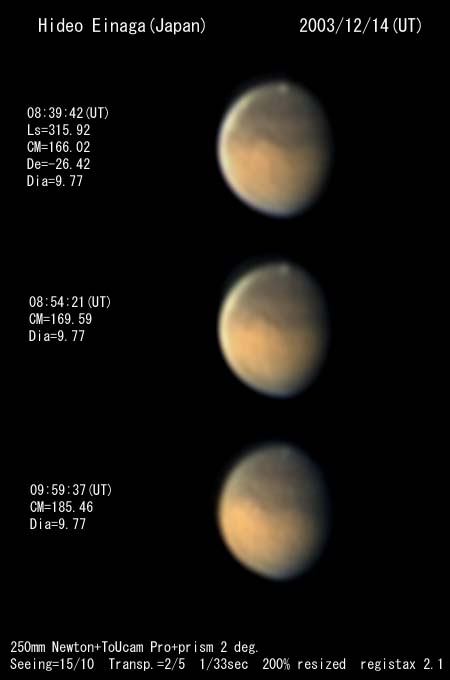
HIDEO EINAGA ≪兵庫県 加西 永長英夫≫
|
Masahito Niikawa (280mm SC, Hand-made PC camera (CCD:ICX424AL))
|
|
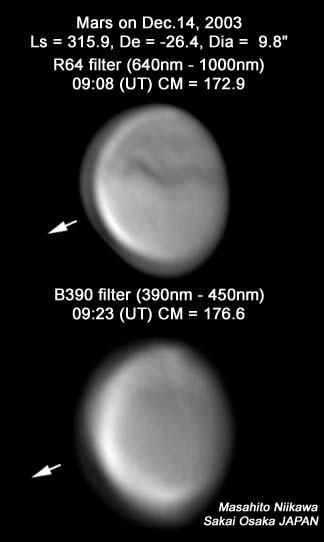
Mars on Dec.14, 2003
Ls = 315.9, De = -26.4, Dia = 9.8"
R64 filter (640nm - 1000nm)
09:08 (UT) CM = 172.9
Exposure 0.03sec
480 frames composite
B390 filter (390nm - 450nm)
09:23 (UT) CM = 176.6
Exposure 0.2sec
624 frames composite
Telescope:C11(D=280mmm fl=2800mm)
Camera:Hand-made PC camera (CCD:ICX424AL)
Effective Fno. = 26 (XP24mm Eyepiece projection)
Seeing = 7/10, Transparency = 3/6
Observer:Masahito Niikawa Sakai Osaka JAPAN
Processed with CRoPP, Registax and Photoshop
Yellow cloud flaw? along the dark pattern.
≪大阪府 堺市 新川勝仁≫
|
Isamu.Hirabayashi(250mm Newton, ToUcam PRO)
|
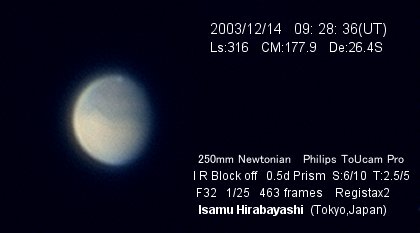
Isamu Hirabayashi (Tokyo,Japan)
≪東京都日野市 平林 勇≫
|
|
Christophe Pellier (180mm Newtonian webcam Toucam Pro)
|
|
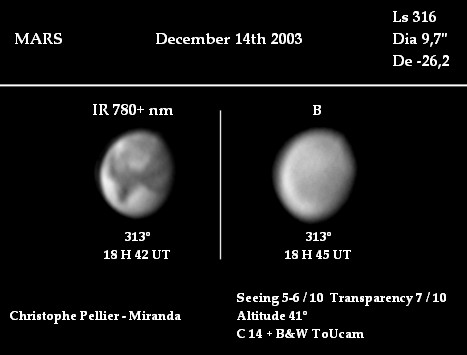 Hello everyone : I have observed Mars tonight in a few lulls, and did manage
to catch two images of the Hellas hemisphere (IR and Blue). It seems that no
dust is visible there, the strange aspect of the Hellas basin may be due to
low resolution only. Images made with a 355mm SCT.
I will possibly have more chance to image Mars this week.
[Christophe Pellier Bruz City , France]
Hello everyone : I have observed Mars tonight in a few lulls, and did manage
to catch two images of the Hellas hemisphere (IR and Blue). It seems that no
dust is visible there, the strange aspect of the Hellas basin may be due to
low resolution only. Images made with a 355mm SCT.
I will possibly have more chance to image Mars this week.
[Christophe Pellier Bruz City , France]
|
Donald C Parker(16-in (41cm) Newtonian)
|
|
Hi All
I have attached a Mars image from 14 December. The dust appears to have
expanded southward. A possible secondary dust cloud in eastern Thaumasia.
See Paul Maxson's image taken 91 minutes later.
Image taken with Tippy D'Auria's Meade 12-in LX200. Miami, FL.


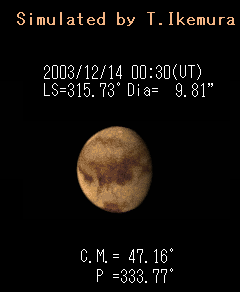 D.C. Parker, S. Faworski, T. D'Auria
Miami, FL. 12-in (32cm) Meade SCT
ToUCam Pro Camera Eyepiece Projection @ f/18.8
Infrared Rejection Filter
Integration Time: 1/25 sec. 10 fps
Processed in K3CCD 600/1201 frames selected (auto).
Images dark corrected.
Seeing fairly good, (7 Pickering) -- pre cold front. Transparency = 4.0-4.5m.
No Wind. Altitude = 62 degrees. Light dew.
Dust expanded southward, covering most of Bosporos Planum
and extending into Argyre. Small bright clouds over Eos
Capri Cornu and possibly in eastern Thaumasia.
Aram Chaos bright - possibly dust.
[ Donald C Parker Coral Gables, Florida U.S.A]
D.C. Parker, S. Faworski, T. D'Auria
Miami, FL. 12-in (32cm) Meade SCT
ToUCam Pro Camera Eyepiece Projection @ f/18.8
Infrared Rejection Filter
Integration Time: 1/25 sec. 10 fps
Processed in K3CCD 600/1201 frames selected (auto).
Images dark corrected.
Seeing fairly good, (7 Pickering) -- pre cold front. Transparency = 4.0-4.5m.
No Wind. Altitude = 62 degrees. Light dew.
Dust expanded southward, covering most of Bosporos Planum
and extending into Argyre. Small bright clouds over Eos
Capri Cornu and possibly in eastern Thaumasia.
Aram Chaos bright - possibly dust.
[ Donald C Parker Coral Gables, Florida U.S.A]
|
Brian Colville(300mm F10 Schmidt-Cass:ToUcam Pro)
|
|

Hello everyone...
I have attached an image of Mars taken December 14th. The image leaves a lot to be desired from an image quality
standpoint, but I believe that it is of interest with the current dust activity.
The image was taken with a 25cm newtonian that I am currently testing for planetary work, trying to avoid the focus
changes that occur with the IR and UV filters. This image was taken at f44 using eyepiece projection with the
ToUcam Pro. The RGB image was taken through a Schuler IRX filter, and the IR image was taken thorough a Schuler
IR83 filter. Each frame is composited from approx 100 of the 800 frames in a 30second video clip. Images were
stacked and processed with Registax2.
The images show a tiny SPC and a bright area covering much of the centre of the disk, roughly south of Chryse to
the Argyre area. Is this some of the dust reported by others during the last week. There are few other features
visible, though I think Sinus Meridiani is visible along the limb on the left side of the image. I would be interested in any
comments on the image that anyone would care to pass along (and corrections of any of the above if necessary).
[ Brian Colville : Cambray Canada]
 ALPO-Japan Latest
ALPO-Japan Latest

 Mars Section
Mars Section
 FROM Makoto ADACHI
-------------------------------------------------------------------------------------
FROM Makoto ADACHI
-------------------------------------------------------------------------------------FROM Makoto ADACHI -------------------------------------------------------------------------------------











Hello everyone : I have observed Mars tonight in a few lulls, and did manage to catch two images of the Hellas hemisphere (IR and Blue). It seems that no dust is visible there, the strange aspect of the Hellas basin may be due to low resolution only. Images made with a 355mm SCT. I will possibly have more chance to image Mars this week. [Christophe Pellier Bruz City , France]


D.C. Parker, S. Faworski, T. D'Auria Miami, FL. 12-in (32cm) Meade SCT ToUCam Pro Camera Eyepiece Projection @ f/18.8 Infrared Rejection Filter Integration Time: 1/25 sec. 10 fps Processed in K3CCD 600/1201 frames selected (auto). Images dark corrected. Seeing fairly good, (7 Pickering) -- pre cold front. Transparency = 4.0-4.5m. No Wind. Altitude = 62 degrees. Light dew. Dust expanded southward, covering most of Bosporos Planum and extending into Argyre. Small bright clouds over Eos Capri Cornu and possibly in eastern Thaumasia. Aram Chaos bright - possibly dust. [ Donald C Parker Coral Gables, Florida U.S.A]

 ALPO-Japan Latest
ALPO-Japan Latest

 Mars Section
Mars Section